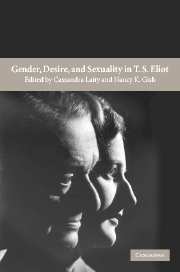Book contents
- Frontmatter
- Contents
- Acknowledgments
- Notes on contributors
- Introduction: Eliot, gender, and modernity
- Part I HOMOEROTICISMS
- Part II DESIRE
- Part III MODERN WOMEN
- Chapter 8 Through schoolhouse windows: women, the academy, and T. S. Eliot
- Chapter 9 T. S. Eliot speaks the body: the privileging of female discourse in Murder in the Cathedral and The Cocktail Party
- Chapter 10 T. S. Eliot, women, and democracy
- Chapter 11 Vipers, viragos, and spiritual rebels: women in T. S. Eliot's Christian society plays
- Index
Chapter 9 - T. S. Eliot speaks the body: the privileging of female discourse in Murder in the Cathedral and The Cocktail Party
Published online by Cambridge University Press: 22 September 2009
- Frontmatter
- Contents
- Acknowledgments
- Notes on contributors
- Introduction: Eliot, gender, and modernity
- Part I HOMOEROTICISMS
- Part II DESIRE
- Part III MODERN WOMEN
- Chapter 8 Through schoolhouse windows: women, the academy, and T. S. Eliot
- Chapter 9 T. S. Eliot speaks the body: the privileging of female discourse in Murder in the Cathedral and The Cocktail Party
- Chapter 10 T. S. Eliot, women, and democracy
- Chapter 11 Vipers, viragos, and spiritual rebels: women in T. S. Eliot's Christian society plays
- Index
Summary
Many of T. S. Eliot's readers have concluded that his treatment of women in the poetry is generally unsympathetic if not entirely unfair. Joseph Bentley once explained that every time he taught Eliot's work, students would ask why the poet seemed not to like women. Sandra Gilbert and Susan Gubar have suggested that Eliot “responded to the threats posed by women … with fantasies of femicide,” while M. Teresa Gibert-Maceda points out that when discussing “Eliot's treatment of women … most readers just label [him] ‘misogynist.’” In light of Prufrock's inability to communicate with the women coming and going around him, the unflattering monologue of the self-absorbed woman in “Portrait of a Lady,” Gerontion's fear of History and her “many cunning passages,” and the shrieking epileptic of “Sweeney Erect,” those responses make sense.
It is useful to ponder, however, the implications of Marianne DeKoven's comment that such “vicious representations of women have been allowed to define Eliot's relationship to the feminine.” Actually, Eliot's relationship to the feminine is far more complex than critics usually concede. The poet's attitude toward women alternated at times among fear, disgust, worship, fascination, hostility, attraction, sympathy, and even understanding. In portions of his later work, Eliot's positive representations of the feminine produce some of the strongest characters in all his writing, the Chorus of the Women of Canterbury in Murder in the Cathedral (1935) and Celia Coplestone in The Cocktail Party (1949).
- Type
- Chapter
- Information
- Gender, Desire, and Sexuality in T. S. Eliot , pp. 195 - 214Publisher: Cambridge University PressPrint publication year: 2004
- 4
- Cited by



